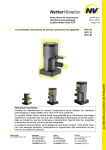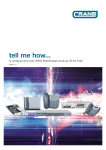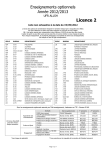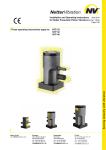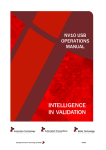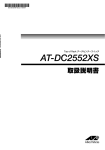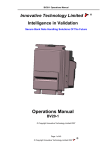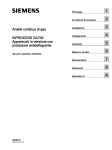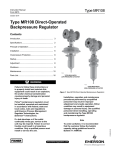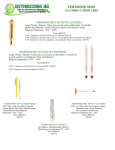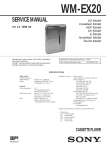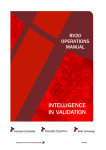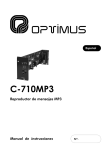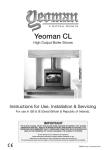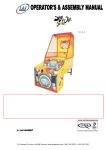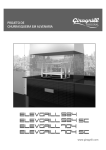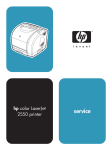Download BV100 operations manual
Transcript
BV100 Operations Manual BV100-1 Operations Manual Innovative Technology Secure Banknote Handling Solutions Of The Future © Copyright Innovative Technology Limited 2007 ® BV100 Operations Manual GA717-1 Revision History INNOVATIVE TECHNOLOGY LTD Title: Drawing No BV100 OPERATIONS MANUAL Author Date FORMAT GA717 RJS Issue Issue A Release Date 10/10/07 Issue 1 04/12/07 10/10/07 Modified By RJS First Draft RJS MS Word 2000 Comments First Release Page 2 of 52 © Copyright Innovative Technology Limited 2007 ® BV100 Operations Manual GA717-1 CONTENTS 1. INTRODUCTION ......................................................................................................................... 5 2. SCOPE OF DOCUMENT ............................................................................................................ 6 3. ENVIRONMENT AND POWER REQUIREMENTS ..................................................................... 7 4. GENERAL DESCRIPTION .......................................................................................................... 8 5. USER INTERFACE: BEZEL LED’S ............................................................................................. 9 6. MACHINE INTERFACE: HARDWARE........................................................................................ 9 6.1 Interface Connector Pin Details ............................................................................................. 10 6.2 Configuration Button Functions .............................................................................................. 11 6.3 Hardware Options .................................................................................................................. 12 7. MACHINE INTERFACE: PROTOCOLS .................................................................................... 13 7.1 Parallel Input and Output: ...................................................................................................... 13 7.2 Pulse Stream Output .............................................................................................................. 14 7.3 Binary Output – BIN ............................................................................................................... 15 7.4 Low Power Option .................................................................................................................. 16 7.5 Serial Input/Output – SIO ....................................................................................................... 18 7.6 Smiley® Secure Protocol - SSP ............................................................................................. 21 7.7 Multi-Drop Bus / Internal Communications Protocol (MDB/ICP)............................................ 22 7.8 CCTalk Protocol – CCT.......................................................................................................... 24 7.9 Other Interfaces available by request from ITL ...................................................................... 24 8. USING BV100 CONFIGURATION CARDS............................................................................... 25 9. MECHANICAL INSTALLATION................................................................................................. 26 10. ROUTINE MAINTENANCE ....................................................................................................... 28 10.1 11. Re-Calibration ........................................................................................................................ 28 SUPPORT TOOLS .................................................................................................................... 29 11.1 Configuration Cards. .............................................................................................................. 29 11.2 ITL Bank Note Validator Currency Manager .......................................................................... 29 11.3 Validator Programming System (DA3) ................................................................................... 30 11.4 Internet Website Support ....................................................................................................... 30 Page 3 of 52 © Copyright Innovative Technology Limited 2007 ® BV100 Operations Manual GA717-1 11.5 E-mail Support ....................................................................................................................... 30 Appendix A – Exploded Diagrams ................................................................................................ 31 Appendix B – ESCROW Control ................................................................................................... 39 Appendix C – Interface Tools DA1 – DA2..................................................................................... 40 Appendix D – Configuration Cards................................................................................................ 42 Appendix E – Cash Boxes............................................................................................................. 50 Appendix F – PC System Specification......................................................................................... 52 Page 4 of 52 © Copyright Innovative Technology Limited 2007 ® BV100 Operations Manual GA717-1 1. Introduction This manual describes the operation of the BV100 Bank note Validator as fitted with Firmware Version 4.00 or greater. CAUTIONS: • THIS PRODUCT MUST BE FITTED WITH A 3 AMP FUSE BEFORE USE. • THE BV100 VALIDATOR IS PIN FOR PIN COMPATIBLE WITH NV7/8/9/10, BUT NOT PIN FOR PIN COMPATIBLE WITH THE NV2/3/4/4X OR 5 SERIES PRODUCTS. • DUE TO DIFFERENT NOTE CYCLE TIMES THERE MAY BE TIMING DIFFERENCES FROM THE NV PRODUCTS. We recommend that you study this manual as there are many new features permitting new uses and more secure applications. If you do not understand any part of this manual please contact the factory, contact details are below, for assistance. In this way we may continue to improve our product. Innovative Technology Ltd. Derker Street Oldham England OL1 4EQ Tel: +44 (0) 161 626 9999 Fax: +44 (0) 161 620 2090 E-mail: [email protected] Web site: www.innovative-technology.co.uk WARNING ONLY SUITABLY TRAINED PERSONNEL SHOULD CARRY OUT ANY WORK ON THIS EQUIPMENT IN ACCORDANCE WITH ALL CURRENT LOCAL, NATIONAL AND INTERNATIONAL HEALTH AND SAFETY REGULATIONS. Smiley® and the ITL Logo are international registered trademarks and they are the property of Innovative Technology Limited. Innovative Technology has a number of European and International Patents and Patents Pending protecting this product. If you require further details please contact the factory. Innovative Technology is not responsible for any loss, harm, or damage caused by the installation and use of this product. This does not affect your local statutory rights. If in doubt please contact Innovative Technology for details of any changes Page 5 of 52 © Copyright Innovative Technology Limited 2007 ® BV100 Operations Manual GA717-1 2. Scope of Document This document is intended for those who will: • Install the BV100 equipment. • Maintain the BV100 equipment. Although information is included which will allow a degree of fault diagnosis and repair, it is recommended that for all but simple mechanical repairs, the unit must be returned to an approved service centre for repair. CAUTIONS: • NEVER EXCEED THE RECOMMENDED ENVIRONMENTAL AND ELECTRICAL LIMITS. • DO NOT ATTEMPT TO LUBRICATE THE MECHANISMS AS THIS MAY AFFECT THE NOTE TRANSPORT. • DO NOT POLISH THE LENS AS THIS MAY ALTER THE OPTICAL CHARACTERISTICS. • IF THE BV100 VALIDATOR IS DISASSEMBLED THE UNIT MUST BE RE-CALIBRATED AND RE INITIALISED, FOLLOWING RE-ASSEMBLY. Innovative Technology Ltd has a policy of continual product improvement. As a result the products supplied may vary from the specification described here. Page 6 of 52 © Copyright Innovative Technology Limited 2007 ® BV100 Operations Manual GA717-1 3. Environment and Power Requirements This section details the Environmental and Power requirements. Environment Temperature Humidity Minimum Maximum +3oC +50oC 5% 95% Non condensing Table 1 - Environmental Requirements CAUTION: • • IF THE INPUT VOLTAGE FALLS BELOW 11.5V THE BV100 MAY NOT OPERATE CORRECTLY (WILL REJECT NOTES). THE FRONT BEZEL LIGHTS WILL FLASH TO INDICATE INCORRECT CONDITIONS IT IS RECOMMENDED THAT THE POWER SUPPLY USED CAN SUPPLY AT LEAST 2.5 AMPS. Electrical Supply Supply Voltage (V DC) Absolute Limits MDB IF5 Version Supply Voltage MDB Hardware version Supply Ripple Voltage Supply Currents: Sleep (Low Power Mode) Standby Validating Peak (Motor Stall) Minimum +11.5V +18V +18V 0 Maximum +14.2V +48V DC or 34V AC +48V DC 0.25V @100 Hz TBC 230mA 500mA 2000mA Table 2 - Power Requirements Interface Logic levels Inputs Logic Low 0V To +0.5V Outputs with 2K2Ω pull up 0.6V Maximum Current Sink 50mA per output Logic High +3.7 V +12V Pull up voltage of host interface Table 3 - Interface Logic Levels Page 7 of 52 © Copyright Innovative Technology Limited 2007 ® BV100 Operations Manual GA717-1 4. General Description BV100 Validator - the next generation of ITL Bank Note Validators The BV100 Bank Note System is a compact note-validating machine (see figure 1), suitable for most money machines. It will accept up to 16 different denominations of notes in the serial control mode. Figure 1 – The BV100 The BV100 Validator leaves the factory preset to at least one currency so that it is ready for immediate installation. If it is required to change the currency data set this may be done using the PC based Validator Management software. Various size cash boxes are available for the BV100, ranging from approximately 350 notes to a maximum of approximately 950 notes (See Appendix E – Cash Boxes for more information). A lock can be fitted to the BV100 to secure the cash box in place. A lock such as Camlock, prod ref. 2181D can be used. New currencies and applications are being tested all the time, please refer to our web site or contact the factory for information concerning specific currencies if they are not already included on our approved list. The BV100 is designed for easy installation in most machines. Interfacing the Validator is very simple, with the choice of the following protocols: SSP PULSE PARALLEL BINARY CCTALK SIO MDB NIS IF30 IF31 IF32 Table 4 – Available Interfaces/Protocols Page 8 of 52 © Copyright Innovative Technology Limited 2007 ® BV100 Operations Manual GA717-1 5. User Interface: Bezel LED’s The Bezel LED’s are used to indicate a variety of status signals as described below in table 5. LED Status Permanent On Slow flash on power up (1 second period) Slow flash (1 second period) Short flash Description Validator enabled ready to accept notes Power supply is incorrect, check specification Validator in Configuration card programming mode Cash box removed Table 5 – Bezel LED status codes 6. Machine Interface: Hardware The BV100 interface connector is located on the left side of the unit; it has 16 pins (see figure 2) refer to Table 6 for the pin allocation. Two are used for the 0V and +12V power supply and there are five outputs and five inputs, the remaining four pins are reserved for factory use and should not be connected. An example mating connector is Molex type Part No: 39-51-2160. It is possible to use the special hardware versions of BV100 in machines operating at 110 Volts or in machines operating at MDB. The BV100 also has a Configuration Button located above the USB Connector (See Figure 2). The USB connector can be used to program the BV100 and for communications when used in SSP and SIO modes. When used for programming, no external power supply is required. When used for the communications, power must be applied to the BV100 via the 16 pin interface connector before connecting the USB cable. Configuration Button 16 Pin Interface Connector USB Connector Figure 2 – Interface Connector Page 9 of 52 © Copyright Innovative Technology Limited 2007 ® BV100 Operations Manual GA717-1 6.1 Interface Connector Pin Details The connector pin details are described below (see table 6); they use an IDC 16-pin 0.1" pitch header with 2 rows of 8 pins. Pin 1 2 15 1 Name Description Open Collector Output. Function changes depending on Machine Interface Protocol. (See individual interface descriptions for details) Also the Pulse Stream output Also the serial Output pin in SSP Serial Mode, and other serial modes Vend 1 2 Vend 2 3 Vend 3 4 Vend 4 5 16 Open Collector Outputs. Function changes depending on Machine Interface Protocol. (See individual interface descriptions for details) Inhibit channel 1 by holding this pin HIGH. To Enable a channel the inhibit must be held LOW. Also the serial Input pin in SSP Serial Mode, and other serial modes Inhibit 1 6 Inhibit 2 Inhibit channel 2 by holding this pin HIGH 7 Inhibit 3 Inhibit channel 3 by holding this pin HIGH 8 Inhibit 4 Inhibit channel 4 by holding this pin HIGH 9 10 Busy BV100 is validating and stacking output. Active low while the BV100 is reading, transporting or stacking a note. Escrow Operate Escrow function by holding LOW (see Appendix B – ESCROW Control for full details) 11 Factory Use Only Do Not Connect 12 Factory Use Only Do Not Connect 13 Factory Use Only Do Not Connect 14 Factory Use Only Do Not Connect 15 +Vin 16 0V Nominal 12V DC supply 0V Supply Table 6 - 16 Pin Connector Details Page 10 of 52 © Copyright Innovative Technology Limited 2007 ® BV100 Operations Manual GA717-1 6.2 Configuration Button Functions The functions available via the Configuration Function Button are detailed in Table 7 Configuration Button Power Status Press & Hold (> 2 sec) Powered ON Sets BV100 to Programming Mode (SSP) Press Once (< 1 sec) Powered ON Enables Configuration Card Programming Press Twice (Within Half a second) Powered ON Current Setting Indicator Press & Hold as power is applied Powered OFF - ON Function Resets ccTalk key to Default setting Table 7 – Configuration Button Functions BV100 Programming Mode Press and Hold the Configuration Button for at least 2 seconds whilst the BV100 is powered up. The Bezel LED will flash rapidly to indicate that SSP is being loaded. Once this process has finished the BV100 will reset. The BV100 will now be in Programming Mode (SSP) and allow connection to a PC via a DA1 or DA2 adapter or connection to a DA3. Note: This mode can only be cancelled by re-programming with a Configuration Card or via the Validator Manager program. Please ensure you are aware of all the BV100 programmed settings before entering this mode. Failure to restore the original setting will stop the BV100 from operating in the Host machine. Configuration Card Programming Mode Press the Configuration Button once whilst the BV100 is powered up. If done correctly the Bezel LED will flash every 1-second. This will allow the insertion of a Configuration Card to change the Firmware Protocol in the BV100. (See Chapter 8 Using BV100 Configuration Cards for full details). This mode can be cancelled by again pressing the Configuration Button once. Current Setting Indicator Mode Press the Configuration Button twice within half a second whilst the BV100 is powered up. The BV100 Bezel LED will then perform a series of flashes to indicate the current settings within the validator. (See Program Check Procedure, page 2 in Appendix D – Configuration Cards) Encryption Key Reset Function (CCTALK) Note: This function will only be possible if the BV100 is programmed to CcTalk mode. It is not possible to reset the key from SSP mode. Press and hold the Configuration Button Whilst the BV100 powered is off. Apply the power and keep the button pressed for several seconds. The ccTalk Encryption key will now be restored to the default setting. Page 11 of 52 © Copyright Innovative Technology Limited 2007 ® BV100 Operations Manual GA717-1 6.3 Hardware Options In addition to the standard BV100, there are different hardware options available of the BV100 as follows: • BV100 – MDB The BV100 MDB contains additional hardware for use in Vending machines operating at higher DC levels. The module provides a regulated 12V dc supply to the validator and has Opto isolated inputs and outputs. For further details on the MDB protocol please see chapter 7.7 • BV100 – 110V The BV100 110V contains voltage regulator hardware that allows the BV100 to be used with machines that operate with a 110V AC supply. Page 12 of 52 © Copyright Innovative Technology Limited 2007 ® BV100 Operations Manual GA717-1 7. Machine Interface: Protocols ITL strongly recommends the use of a Serial protocol (Preferably SSP) to achieve the highest security. 7.1 Parallel Input and Output: To use Parallel Output for 4-note/channel acceptance the Parallel interface must be programmed into the validator via the Configuration Cards (See Appendix D – Configuration Cards) or via the ITL BNV Currency Manager program. Vend Signals: (Pins 1 to 4). The four channels have their own individual outputs. If a note is recognised then the relevant Vend line is set low for a period of 100 ± 3ms. Pulses outside these limits should be rejected as a precaution against false triggering. Busy Output: (Pin 9). This is a general-purpose busy signal. It is active low while the BV100 is in operation. Escrow Control: (Pin 10) Hold this pin Low to enable the single note escrow function. (See Appendix B – ESCROW Control). If the host machine aborts the transaction by setting the corresponding inhibit input high, the note is returned immediately. The host machine can force the return of the note to the customer by setting the inhibit line high, at any time before the end of the 30 second time-out. Setting high all the inhibits causes a note reject. In the event of a note being forcibly removed from the mouth of the BV100 during the 30-second interval, the BV100 will go out of service for 45 seconds. Inhibit Operation: (Pins 5 – 8) Channel 1 to 4 have their own inhibit input to allow the host machine to refuse specified notes. To inhibit a channel, the relevant inhibit input must be held high. To enable a channel, the corresponding inhibit must be latched low so that notes may be accepted. If all four inhibits are high simultaneously then the BV100 will be disabled. In this state the bezel LED will not illuminate and if a note is inserted the motor will run in reverse preventing the insertion of the note. All four inhibits may be connected together to create a 'global' inhibit. In this way the BV100 may be brought in and out of operation by the host machine. It is possible to operate the BV100 in Low power mode with the Parallel interface. For further details please see Chapter 7.4 Page 13 of 52 © Copyright Innovative Technology Limited 2007 ® BV100 Operations Manual GA717-1 7.2 Pulse Stream Output To use pulse stream output for acceptance of up to 16 note/channel acceptance, The Pulse interface must be programmed into the validator via the Configuration Cards (See Appendix D – Configuration Cards) or via the ITL BNV Currency Manager program. Vend Signal: (Pins 1) When a note is recognised vend 1 will pulse a pre set number of times, the number of pulses can be set via the ITL BNV Currency Manager program (and set to default values with supplied dataset). The pulse width can be set either with the ITL BNV Currency Manager program or via the Configuration Cards (See Appendix D – Configuration Cards) Busy Output: (Pin 9). This is a general-purpose busy signal. It is active low while the BV100 is in operation. Escrow Control: (Pin 10). No escrow function in this mode Inhibit Operation: (Pins 5 – 8) Channels 1 to 4 have their own inhibit input to allow the host machine to refuse specified values of notes. To inhibit a channel, the relevant inhibit input must be held high. To enable a channel, the corresponding inhibit must be latched low so that notes may be accepted. If all four inhibits are high simultaneously then the BV100 will be disabled. In this state the bezel will not illuminate and if a note is inserted the motor will run in reverse preventing the insertion of the note. Note: Channels higher than four cannot be individually inhibited, but will be globally inhibited if inhibits 1 to 4 are inhibited. It is possible to operate the BV100 in Low power mode with the Pulse interface. For further details please see Chapter 7.4 Credit Hold Function: If this function is enabled in pulse mode by Configuration card or ITL BNV Currency Manager program, the validator will take the note as normal but then wait until the escrow line is toggled low/high before. It will then give out the number of pulses per dollar as set on the programming card. After the pulses have been given, the validator will then wait for another low/high toggle until the full value of credit pulses are given. For example with a setting of 2 pulses per dollar, a five dollar bill will give 2 pulses, 5 times. A Typical use of this option would be for a Pool table with a game price of $1. You could insert a $5 note and press a button that toggles the escrow line and releases the pool balls, this would then allow you to play the first game. The Validator holds onto the remaining credits until the game has finished and the button is pressed again allowing the next game to begin, this continues until all the credits have been used. The busy line remains low throughout the whole process and the validator remains inhibited until all pulses are given. Page 14 of 52 © Copyright Innovative Technology Limited 2007 ® BV100 Operations Manual GA717-1 7.3 Binary Output – BIN To use Binary mode The Binary interface must be programmed into the validator via the Configuration Cards (See Appendix D – Configuration Cards) or via the ITL BNV Currency Manager program. In the event that the machine needs more than 4 notes to be recognised, but the host machine cannot take advantage of the serial communication methods then the BV100 can be set to give a binary pattern output on the four parallel output pins. If the BV100 is set to binary mode it will issue the vend signals as a binary pattern on the parallel outputs for 100 ± 3ms. In this way a maximum of 15 different notes can be accepted and 4 notes individually inhibited. Vend Signals: (Pins 1 to 4). The four channels have their own individual outputs. If a note is recognised the binary representation of the channel number will be pulled low for 100 ± 3ms. Pulses outside these limits will be rejected as a precaution against false triggering due to noise. Busy Output: (Pin 9). This is a general-purpose busy signal. It is active low while the BV100 is in operation. Escrow Control: (pin 10). Hold this pin Low to enable the single note escrow function. (See Appendix B – ESCROW Control). If the host machine aborts the transaction by setting the corresponding inhibit input high on pin 10, the note is returned immediately. The host machine can force the return of the note to the customer by setting the inhibit line high, at any time before the end of the 30 second time-out. Setting all the inhibits high causes a note reject. In the event of a note being forcibly removed from the mouth of the BV100 during the 30-second interval, the BV100 will go out of service for 45 seconds. Inhibit Operation: (Pins 5 – 8) Channels 1 to 4 have their own individual inhibit input to allow the host machine to refuse specified values of notes. To inhibit a channel, the relevant inhibit input must be held high. To enable a channel the corresponding inhibit must be latched low so that notes may be accepted. If all four inhibits are high simultaneously then the BV100 will be disabled. In this state the bezel will not illuminate and if a note is inserted the motor will run in reverse preventing the insertion of the note. Note: Channels higher than four cannot be individually inhibited, but will be globally inhibited if inhibits 1 to 4 are inhibited. It is possible to operate the BV100 in Low power mode with the Binary interface. For further details please see Chapter 7.4 Page 15 of 52 © Copyright Innovative Technology Limited 2007 ® BV100 Operations Manual GA717-1 7.4 Low Power Option Notes: • Low Power Mode can ONLY be used with the above Parallel, Pulse and Binary protocols. • Low power mode can only be enabled by correctly completing the configuration cards or via the ITL BNV Currency manager program. • In Low Power Mode the front sensor is checked every 1 second which can lead to a delay in accepting the note when it is presented. • Configuration button functions are only available during power up before the BV100 goes into Low Power mode Electrical Supply Supply Voltage (V DC) Absolute Limits MDB IF5 Version Supply Voltage MDB Hardware version Supply Ripple Voltage Supply Currents: Sleep (Low Power Mode) Standby Validating Peak (Motor Stall) Minimum +11.5V +18V +18V 0 Maximum +14.2V +48V DC or 34V AC +48V DC 0.25V @100 Hz TBC 230mA 500mA 2000mA Low power Mode can be used with all none serial communication protocols to reduce the power consumption of the BV100 when idle. When the BV100 is in this state the current consumption is reduced. The BV100 goes into low power mode approximately 6 seconds after the validator is powered up and remains in this state until a note is entered (Time A). Following a note insertion the BV100 returns to Low Power mode approximately 1 second after the Busy line goes High (After credit is given or note is rejected). (Time B) Page 16 of 52 © Copyright Innovative Technology Limited 2007 ® BV100 Operations Manual GA717-1 Low Power mode uses 3 control lines: Vend – Pin 1, Inhibit – Pin 5 and Busy – Pin 9 Inhibit 0V Busy A 0V Vend Validating Stacking 0V Sleep Vend / Credit Wake Up Enabled Validator Note Inserted B Figure 3 - Low Power Mode Timing Diagram TIMING DIAGRAM EXPLAINATION When the Validator is enabled the Inhibit line is Low and the Busy line is High. This remains the same until a note is inserted (Time A) When a note is inserted under the front sensor the BV100 wakes up and the busy line goes low to indicate that the validator is in use. The busy line remains low during the validating and stacking process and once the note has been successfully validated and stacked the vend line goes low to issue the credit. After the credit is issued the busy line goes high and approximately 1 second after the busy line goes high (Time B) the BV100 goes back into low power mode. Page 17 of 52 © Copyright Innovative Technology Limited 2007 ® BV100 Operations Manual GA717-1 7.5 Serial Input/Output – SIO Existing Smiley® NV4 - NV10 users may already be using the serial input/output facility in conjunction with the parallel inputs. The BV100 Validator also supports this system. However this interface is not recommended for new designs, the Smiley® Secure Protocol SSP interface is recommended. CAUTION: • • • THE BV100 DOES NOT SUPPORT THE SIMPLE SERIAL DATA OUT ONLY MODE AS AVAILABLE ON NV4 AND EARLIER MODELS NV2 AND NV3. IT ONLY SUPPORTS THE SERIAL DATA INPUT/OUTPUT MODE. THE HOST MACHINE DOES NOT ECHO MESSAGES BACK TO THE VALIDATOR. THE BV100 DOES NOT OPERATE IN TRUE RS232 MODE. (ONLY TTL LEVEL). To use Serial Input/Output mode The SIO interface must be programmed into the validator via the Configuration Cards (See Appendix D – Configuration Cards) or via the ITL BNV Currency Manager program. There are 4 different combinations of SIO available SIO 300 Baud SIO 300 Baud (Disabled at Start up) - A software enable must be sent to enable the validator. SIO 9600 Baud SIO 9600 Baud (Disabled at Start up) - A software enable must be sent to enable the validator. The data is formatted as follows for 300 Baud 1-start bit - 8 data bits - 2 stop bits Vend 1 (pin 1) Idle Start Bit 0 Bit 1 Bit 2 Bit 3 Bit 4 Bit 5 Bit 6 Bit 7 Stop 0 1 0 0 0 =20dec Stop Idle 3.3ms 0 0 1 Figure- 4 Typical Serial Output: Transmission of the value 20 (decimal), Note not recognized The data is formatted as follows for 9600 Baud 1-start bit - 8 data bits - 1-stop bits Vend 1 (pin 1) Idle Start Bit 0 Bit 1 Bit 2 Bit 3 Bit 4 Bit 5 Bit 6 Bit 7 Stop 0 1 0 0 0 =20dec Idle 0.1ms 0 0 1 Figure- 5 Typical Serial Output: Transmission of the value 20 (decimal), Note not recognized Page 18 of 52 © Copyright Innovative Technology Limited 2007 ® BV100 Operations Manual GA717-1 The BV100 will receive and transmit the following event codes: Recognised Receive Codes to BV100 Transmitted codes from BV100 MESSAGE DECIMAL VALUE MESSAGE DECIMAL VALUE Inhibit C1 131 Note Accept on C1 1 Inhibit C2 Inhibit C3 Inhibit C4 Inhibit C5 Inhibit C6 Inhibit C7 Inhibit C8 Inhibit C9 Inhibit C10 Inhibit C11 Inhibit C12 Inhibit C13 Inhibit C14 Inhibit C15 Inhibit C16 Un-inhibit C1 Un-inhibit C2 Un-inhibit C3 Un-inhibit C4 Un-inhibit C5 Un-inhibit C6 Un-inhibit C7 Un-inhibit C8 Un-inhibit C9 Un-inhibit C10 Un-inhibit C11 Un-inhibit C12 Un-inhibit C13 Un-inhibit C14 Un-inhibit C15 Un-inhibit C16 Enable serial escrow mode Disable serial escrow mode Accept Escrow Reject Escrow Status Enable all 132 133 134 135 136 137 138 139 140 141 142 143 144 145 146 151 152 153 154 155 156 157 158 159 160 161 162 163 164 165 166 170 171 172 173 182 184 Note Accept on C2 Note Accept on C3 Note Accept on C4 Note Accept on C5 Note Accept on C6 Note Accept on C7 Note Accept on C8 Note Accept on C9 Note Accept on C10 Note Accept on C11 Note Accept on C12 Note Accept on C13 Note Accept on C14 Note Accept on C15 Note Accept on C16 Note Not Recognised Mechanism running slow Strimming attempted Channel 5 Note Rejected (fraud channel) STACKER Full or Jammed Abort During Escrow Note may have been taken to clear jam Validator Busy Validator Not Busy Command Error 2 3 4 5 6 7 8 9 10 11 12 13 14 15 16 20 30 40 50 60 70 80 120 121 255 Disable all 185 Disable escrow timeout 190 Enable escrow timeout 191 Table 8 - Receive and Transmit Codes Page 19 of 52 © Copyright Innovative Technology Limited 2007 ® BV100 Operations Manual GA717-1 Example transactions are shown below (see table 9): Event Validator Note entered into validator Note Accepted Channel 2 Note entered into validators Note not recognised Validator has returned note Software Inhibit Channel 4 Software Enable Channel 4 Validator Busy Validator Ready Accept on Channel 2 Validator Busy Validator Ready Note not recognised Validator Ready Inhibit C4 Channel 4 Inhibited Uninhibit C4 Channel 4 Inhibited Status Report Status Requested Inhibit status Channels 1-8 Inhibit status Channels 916 Escrow On (=1) / Off (=0) 3 byte status message Turn on Escrow Mode Note accept in Escrow Mode Note entered into validator Note Accepted Channel 2 Decimal Value 120 121 2 120 121 20 121 134 134 154 154 182 182 Byte 1 Byte 2 Byte 3 170 Escrow Mode Enabled 170 Validator Busy Validator Ready Accept on Channel 2 120 121 2 172 Accept Escrow Accept on Channel 2 Host Inhibit C4 Uninhibit C4 Status Request Enable Escrow Mode Accept Note in Escrow 172 2 Table 9 - Example Protocols Page 20 of 52 © Copyright Innovative Technology Limited 2007 ® BV100 Operations Manual GA717-1 7.6 Smiley® Secure Protocol - SSP NOTE: Please refer to the Smiley® Secure Protocol (SSP) Specification (ITLDrawing GA138) on the web site for full details of the SSP protocol. To use SSP mode The SSP interface must be programmed into the validator via the Configuration Cards (See Appendix D – Configuration Cards) or via the ITL BNV Currency Manager program, or by pressing and holding the Configuration Button for more than 2 seconds. SSP is a secure serial interface specifically designed to address the problems experienced by cash handling systems in gaming machines. Problems such as acceptor swapping, reprogramming acceptors and line tapping are all addressed. This interface is recommended for all new designs. The interface uses a master slave model, the host machine is the master and the peripherals (note acceptor, coin acceptor or coin hopper) are the slaves. Data transfer is over a multi-drop bus using clock asynchronous serial transmission with simple open collector drivers. The integrity of data transfers is ensured through the use of 16 bit CRC checksums on all packets. Each SSP device of a particular type has a unique serial number; this number is used to validate each device in the direction of credit transfer before transactions can take place. Commands are currently provided for coin acceptors, note acceptors and coin hoppers. All current features of these devices are supported. Features: • Serial control of Note / Coin Validators and Hoppers • 4 wire (Tx, Rx, +V, GND) system • RS232 (TTL) - open collector driver • High Speed 9600 Baud Rate • 16 bit CRC error checking • Data Transfer Mode Benefits: • Proven in the field • Simple and low cost interfacing of transaction peripherals. • High security control of payout peripherals. • Defence against surrogate validator fraud. • Straightforward integration into host machines. • Remote programming of transaction peripherals • Open standard for universal use. For detailed information and full protocol specification please refer to SSP Interface Specification ITL (Drawing GA138), this is available from the ITL website www.innovative-technology.co.uk. To help in the software implementation of the SSP, ITL can provide DLL controls and Visual Basic applications on request. Please contact [email protected] for more information. Page 21 of 52 © Copyright Innovative Technology Limited 2007 ® BV100 Operations Manual GA717-1 7.7 Multi-Drop Bus / Internal Communications Protocol (MDB/ICP) To use the MDB mode an MDB BV100 or an IF5 interface box can be used. The MDB interface must be programmed into the validator via the Configuration Cards (See Appendix D – Configuration Cards) or via the ITL BNV Currency Manager program, Note: An IF5 cannot be used with an MDB BV100. A standard BV100 can only be used in MDB with the addition of an IF5 interface. Please refer to the Multi-Drop Bus specification for the suggested current drive circuits available. The BV100 supports the MDB protocol version 1, level 1 For detailed information and full protocol specification please refer to www.vending.org MDB defines a serial bus interface used in electrically controlled vending machines (see figure 6). This is a 9600 Baud Master-Slave system where the BV100 banknote validator is a slave to a master controller. A master has the capability of communicating with 32 peripherals or slaves. The master is defined as the Vending Machine Controller (VMC). Receive Transmit Figure 6 – MDB Opto Isolated Input / Output circuits BV100 MDB Slave The BV100 banknote Validators have a unique address – 00110XXX binary (30H). The VMC polls the bus to detect presence of the BV100 Validator or get information on the current status of the Validator. The Validators will respond when asked for activity with an acknowledgment, a negative acknowledgment or a specific reply, depending on its current status. Bus crashes are avoided as the Validators respond to being polled only by the VMC. The international country code must be set for the country in which the Validators will be operating. This is either the international telephone code for that country, or the country code taken from ISO4217. The code is represented as two bytes. The initial digit signifies the source of the code. 0 signifies the telephone code is used, 1 signifies ISO4217 has been used. For the USA the country code is 00 01, or 18 40 For Great Britain the code is 00 44, or 18 26. The scaling factor must also be specified for each Validator. All accepted note values must be evenly divisible by this number. • This number would be set to 100 (Hex 64) for the Euro or Great Britain. • The number would be set to 1000 (Hex 03E8) for Columbia. The number of decimal places must also be programmed for each Validator Page 22 of 52 © Copyright Innovative Technology Limited 2007 ® BV100 Operations Manual GA717-1 • The number would be set to 2 for Euro or USA • The number would be set to 3 for Columbia Adopting the numbers above: • £5 would be displayed as 5.00 • £10 would be displayed as 10.00 • $1 would be displayed as 1.00 • 1K Columbia would be displayed as 1.000 Page 23 of 52 © Copyright Innovative Technology Limited 2007 ® BV100 Operations Manual GA717-1 7.8 CCTalk Protocol – CCT The BV100 supports the ccTalk serial protocol for easy interfacing with host machines that support this protocol. To use ccTalk mode The CCT interface must be programmed into the validator via the Configuration Cards (See Appendix D – Configuration Cards) or via the ITL BNV Currency Manager program, Pin out connections on BV100 for ccTalk are shown below (see figure 7) looking at the connection pins on the BV100 interface connector as defined in the ccTalk specification. It is recommended that all communications with the note validator must be encrypted using the encryption key, the default encryption key will be printed on the label of the BV100. To reset the Encryption key to it’s default value see Chapter 6.2. NOTE: For detailed information and full protocol specification please refer to www.cctalk.org 16 2 15 1 0V +12V RX TX CCTalk Bus Figure 7 - CCTalk Connection Pins on the BV100 7.9 Other Interfaces available by request from ITL • • • • NIS – Compatible with Mars Non-Isolated Serial Protocol IF30 – Compatible with ID003 protocol IF31 – Special interface (Columbia) IF32 – Compatible with Cash Code CCnet Protocol Page 24 of 52 © Copyright Innovative Technology Limited 2007 ® BV100 Operations Manual GA717-1 8. Using BV100 Configuration Cards The Configuration Cards offer the following functions: • Select required Communication Interface (SSP, ccTalk, Parallel etc). • Adjust the channel and pulse configuration on a pre-programmed BV100 to your own requirements. Programming the BV100 with the configuration cards is enabled via the ‘Configuration Button’ on the right hand side of the BV100 (see Chapter 6.2 Configuration Button Functions). (For details on how to complete the configuration cards please see Appendix D – Configuration Cards) 1) Press the Configuration button once whilst the validator is powered up. 2) The bezel LEDs will now flash with a steady heartbeat until a Configuration Card is entered. 3) Once the Configuration Card has been entered the validator reads the card and immediately returns it. 4) The LEDs then flash rapidly whilst the interface is being changed. If the LEDs flash a number of times slowly, it is an indication of an error (For details of the Error Flash codes please see page 1 of Appendix D – Configuration Cards 5) When the changes are complete the validator resets. If a configuration card is not entered, this function can be cancelled by pressing the button again Once. It is now possible to check the programmed settings of the BV100 by pressing the Configuration button twice within half a second. (For details see page 2 of Appendix D – Configuration Cards) Page 25 of 52 © Copyright Innovative Technology Limited 2007 ® BV100 Operations Manual GA717-1 9. Mechanical Installation The BV100 validator is available with either a 66mm or 72mm Bezel. See drawing number GA700 for dimensions Page 26 of 52 © Copyright Innovative Technology Limited 2007 ® BV100 Operations Manual GA717-1 10. Routine Maintenance The BV100 Validator has been designed to minimise any performance variation over time. Much of this is achieved by careful Hardware and Software design. However, depending upon the environment in which it is used the BV100 may at some time require re-calibration. 10.1 Re-Calibration The BV100 has an in-built self-calibration system that maintains the optical sensors at their best operating point. However if the BV100 is disassembled for any reason it will need to be re-calibrated. Re-calibration may only be performed under license from ITL, contact [email protected] for further details. This can be performed in conjunction with the diagnostics software option in the ITL BNV Currency Manager Program and help menus supplied with this program. Page 28 of 52 © Copyright Innovative Technology Limited 2007 ® BV100 Operations Manual GA717-1 11. Support Tools The following support tools are available for use with the BV100 Bank Note Validator: • ITL Bank Note Validator Currency Manager Software. • Configuration Cards. • Validator Programming System (DA3) • Downloads from the Innovative Technology Ltd website: www.innovative-technology.co.uk • E-mail Support via [email protected] 11.1 Configuration Cards. For full details of the use and function of the Configuration Cards please see Appendix D – Configuration Cards 11.2 ITL Bank Note Validator Currency Manager NOTES: • The Validator must be set to Programming Mode (SSP) when connected to a computer or DA3 and then returned to the original Settings when complete (See Chapter 6.2 Configuration Button Functions). • ITL BNV Currency Manager 3.2.0 or Higher must be used to access the BV100 functions • Datasets can only be downloaded to a BV100 with the correct bezel width for the currency. For example a USD dataset can only be downloaded to a 66mm BV100. A Euro dataset can only be downloaded to a 72mm BV100 The ITL BNV Currency Manager software offers the following functions: • Program the Validator by downloading pre-prepared currency data via the DA1 or DA2 kit. • Check the firmware version and currency set already loaded on a BV100 unit. • Adjust the channel and pulse configuration on a pre-programmed BV100 to your own requirements. • Download a new version of firmware onto the BV100. • Use diagnostic functions to check Validators operation The software will run on an IBM compatible Personal Computer with Pentium™ processor or equivalent (see Appendix F – PC System Specification for operating system requirements). The BV100 can be connected directly via the USB port, or with either a DA1 kit fitted to the serial port or DA2 kit fitted to the USB port. (See Appendix C – Interface Tools DA1 – DA2) Page 29 of 52 © Copyright Innovative Technology Limited 2007 ® BV100 Operations Manual GA717-1 11.3 Validator Programming System (DA3) The DA3 is a programming system designed to enable the programming of ITL Bank Note Validators in the field without the use of a PC. Once the DA3 has been programmed the user can: • Update the existing software within a validator to the latest versions using the BNV Match Download function. • Reprogram the validator to accept a different currency using the BNV Override Download function • Test the functionality of the validator away from the Host machine. For full DA3 operation and functionality details please refer to the DA3 User Manual (Document number GA339) Note: When using the DA3 BNV Match Download function, any pulses and channel allocations programmed into the BV100 will not be retained. The user must ensure that the required dataset options are set and saved before programming the DA3. When programming a BV100 using the DA3 BNV Override Download function, the firmware interface is unchanged. A Configuration Card must be used after reprogramming if a different interface is required. 11.4 Internet Website Support The Innovative Technology Ltd website provides the means to download new and updated currency sets and new versions of firmware for the BV100. You can obtain these along with technical bulletins by visiting www.innovative-technology.co.uk 11.5 E-mail Support If the data you require is not available over the Internet Innovative Technology supports an e-mail system to help customers with unusual requirements. The address is: [email protected] Page 30 of 52 © Copyright Innovative Technology Limited 2007 ® BV100 Operations Manual GA717-1 Appendix A – Exploded Diagrams Exploded Diagram Parts List Part No FD108 LB152 11.5.1.1 Description note drive belt BV note grip pad Qty Drawing number 2 GA706 2 GA705 MC226 MC230 MC235 MC237 MC255 MC258 stacker drive shaft BV Security tooth Brass helical 12t 0.5m BV stacker thrust washer Gearbox shaft wheel axle 1 1 1 1 3 2 GA707 GA711 Not available as spare, only as part of assembly GA710 Not available as spare, only as part of assembly GA706 PM700 PM701 PM761 PM702 PM762 PM704 PM705 PM706 PM707 PM708 PM709 PM710 PM711 PM712 PM713 PM714 PM715 PM716 PM717 PM718 PM719 PM720 PM721 PM722 PM723 PM724 main frame unit cable side (narrow) unit cable side (wide) unit side (narrow) unit side (wide) motor frame - stacker module case module path module cover plate front cover plate lightguide lightguide shield Calibration strip bill push plate outer lift arm inner lift arm worm wheel - stacker drive crank arm gear crank arm - extended crank arm - recess belt drive wheel belt drive wheel flange flanged roller wheel roller bush roller wheel - clip in pressure wheel 1 1 1 1 1 1 1 1 1 1 2 2 2 1 1 1 1 1 1 1 2 2 6 2 2 10 GA706; GA707 GA705 GA705 GA705 GA705 GA710 GA708 GA708 GA708 GA705 GA706; GA708 GA706; GA708 GA706; GA708 GA705 GA707 GA707 GA707 GA707 GA707 GA707 GA706 GA706 GA706 GA706 GA706 GA708 PM726 PM727 PM728 stacker worm 0.7m stacker drive bush stacker drive collar 1 1 1 GA710 GA710 Not available as spare, only as part of assembly PM732 PM733 PM734 belt tension pulley cashbox latch cash box body 2 1 1 GA706 GA705 Not available as spare, only as part of assembly Page 31 of 52 © Copyright Innovative Technology Limited 2007 ® BV100 Operations Manual GA717-1 Exploded Diagram Parts List (continued) Part No PM738 PM739 PM740 Description lightpipe - push plate down bezel Bezel lightguide Qty 1 1 1 Drawing number GA706 GA705 GA705 PM742 PM745 PM746 PM747 cashbox lid Start sensor upper lightpipe Start sensor lower lightpipe Cashbox position lightpipe 1 1 1 1 Not available as spare, only as part of assembly GA708 GA706 GA708 PM751 Rear pressure wheel 2 GA705 PM763 PM764 PM765 PM766 PM767 Gearbox base plate Gearbox top plate Compound gear 1 Compound gear 2 Drive shaft 1 1 1 2 1 Not available as spare, only as part of assembly Not available as spare, only as part of assembly Not available as spare, only as part of assembly Not available as spare, only as part of assembly Not available as spare, only as part of assembly OP111 yellow filter 2 GA706; GA708 SC113 SC119 SC123 SC124 SC126 SP127 SP141 SP142 SP143 SP144 SP146 CN279 MR108 MR111 No4x6mm flange head pozi M3x10 torx plastite pan head M2.6x4 motor screws 4X12 Torx pan BZP M2x6 motor screw board support and cashbox latch Ball bearing spring 3x20.5 lg closed coil spring shaft 3 x 27.5 lg closed coil spring shaft Belt tensioner spring BV cashbox door spring Cable Assy stacker motor belt drive motor 3 2 2 9 2 3 2 4 6 2 2 1 1 1 GA708 GA706 GA710 GA705; GA708 GA709 GA705 GA705 GA708 GA708 GA706 Not available as spare, only as part of assembly GA708 Not available as spare, only as part of assembly Not available as spare, only as part of assembly Page 32 of 52 © Copyright Innovative Technology Limited 2007 ® BV100 Operations Manual GA717-1 Appendix B – ESCROW Control The BV100 has a single note escrow facility (pin 10) used in Parallel and Binary modes. This allows the Validator to hold onto the note once accepted, and then only stack the note in the cash box when the host machine confirms that the Vend operation has been completed. If no confirmation of the Vend is received then the note will be returned to the customer after 30 seconds, (see figure 8). 30sec Do not wait more than 30 seconds for the 2nd vend confirmation signal Escrow Vend Signal 100m 100m Escrow Escrow held low Vend Signal Inhibit rejection can be at any time during the 30 second decision period after completion of the vend Inhibit Figure 8 - Escrow Timing Diagram for Parallel Vends If the host machine itself aborts the transaction by setting the corresponding inhibit input high, the note is returned immediately. The sequence of operations is as follows: • Pin 10 held low awaiting note insertion. • Note inserted. Validator issues a 100ms pulse on the appropriate channel. • The host machine initiates vend process. • The host machine sets pin 10 high to indicate that it wants the note. If this is not done within 30 seconds the Validator will return the note. • The Validator issues a 100ms pulse on the appropriate channel after pin 10 going high to indicate final acceptance of the note. If the signal has not been received within 30 seconds it indicates the customer has forcibly retrieved the note and the vend will be aborted. • The vend process is completed. • The host machine sets pin 10 low in expectation of the next vend. The host machine can force the return of the note to the customer by setting the inhibit line high, at any time before the end of the 30 second time-out. For channels above 4, setting all the inhibits high will cause a note reject. In the event of a note being forcibly removed from the mouth of the BV100 during the 30-second interval, the BV100 will go out of service for 45 seconds. Page 39 of 52 © Copyright Innovative Technology Limited 2007 ® BV100 Operations Manual GA717-1 Appendix C – Interface Tools DA1 – DA2 The DA1/2 Kits are designed for the following: • • Connecting of ITL Note Validators to a PC for the upgrade and user option setting of Currency and Firmware files. Testing note acceptance of Note Validators independent of the host machine to confirm that the validator is working. The DA1and DA2 Kits comprise the following components: DA1 DA1 adapter board DA1 to NV7-10 and BV cable DA1 to NV4 Cable Power Cable ITL Support CD-ROM DA2 DA2 adapter board USB type-A to Type-B cable DA2 to NV7-10 and BV cable Power Cable ITL Support CD-ROM Connecting a DA1 to a validator and PC For the PC system specification and set up refer to Appendix F – PC System Specification. Connect the DA1 to the validator as shown below (see figure 9), using the 16-way to 5-way connector. The supplied 3.5mm jack plug and 2 banana plugs are used to supply power to the DA1 when using a variable Bench power supply (Connect the +12 volts to the red banana plug and GND (0V) to the black plug). Alternatively a Portable DC Power Adapter supplying 12v and 1.5A minimum can be used. Plug the 9-way D-type connector into the serial port of the PC and note of the number of the port, as this will be needed later for configuring the software. Once the connections have been made install the appropriate software for the validator you are using. NOTE: The Validator must be in Programming mode when connected to a computer and then returned to the Original Settings when the download is complete Figure 9 – Connecting DA1 to BV100 and PC for upgrading Validator programs Page 40 of 52 © Copyright Innovative Technology Limited 2007 ® BV100 Operations Manual GA717-1 Connecting a DA2 to a validator and PC Figure 10 – Connecting DA2 to a BV100 and PC for upgrading Validator Programs Software Installation DA1 - To install the ITL BNV Download Manager Software insert the CDROM into the correct PC drive. The CD should automatically run and an installation menu will appear. Double click the ITL BNV Download Manager and follow the on-screen instructions. You can also install the Currency files, Firmware files and the Technical Manuals for each specific product as well as other generic documentation. The Quick Start Guide for the DA1 is Document number GA151. DA2 - To install the ITL BNV Download Manager Software insert the CDROM into the correct PC drive. The CD should automatically run and an installation menu will appear. Double click DA2 installation guide (GA338) and follow the instructions relating to your specific Operating System. NOTE: All files contained on the CD are available from the ITL Website: www.innovative-technology.co.uk Please contact [email protected], if you require further assistance. Page 41 of 52 © Copyright Innovative Technology Limited 2007 ® BV100 Operations Manual GA717-1 Appendix D – Configuration Cards The following pages contain document number GA713. To print the cards, ensure that the page scaling is set to ‘none’. Always ensure that the card has printed with the correct dimensions before use. Page 42 of 52 © Copyright Innovative Technology Limited 2007 ® GA 713 BV Configuration Option Progamming Instructions for use Insert this end first 1 - Cut card around outline - check measurements as printed. Check print options ‘Page scaling’ is set to ‘None’ when printing a pdf file to ensure correct size. IF 30 IF 31 CCTALK SIO PARALLEL I/F Spare 4 NIS IF 32 I/F Spare 1 I/F Spare 2 I/F Spare 3 High 50ms High 100ms Low 50ms Low 100ms 1 4 2 8 Bill 1 Bill 5 Bill 2 Bill 6 Bill 3 Bill 7 Bill 4 Bill 8 High Speed cctalk plain Start Disabled cctalk 8 bit chk Low Power Binary Credit Hold option spare 3 66mm OK BAD 3 - Power-up BV and allow to reset. 4 - Click ‘Function’ button on BV to access Configuration Mode, BV bezel LEDs should be flashing at 1 second interval. 5 - Enter card into BV in direction indicated by arrows. 204mm MDB GOOD Speed PULSE Pulses Per Dollar SSP 6 - Card will be rejected and if configuration was good the, bezel LEDs will flash at a fast rate while programming takes place. TAKE CARE TO ENSURE THE POWER IS NOT REMOVED AT THIS STAGE, THE BV MAY SUFFER PERMANENT DAMAGE !! The BV will then reset. 7 - If an error has occurred, the card will be rejected and the bezel LEDs will flash slowly a number of times to indicate the error cause. (See table below for codes). 8 - IMPORTANT - CHECK THAT THE CONFIGURATION REQUESTED HAS BEEN SET IN THE BV BEFORE USE! Flash Error ______________________________________________ 2 V1.5 Options Inhibits Pulse Settings Interface 2 - Fill in sections as required. Take care to fill in the sections correctly, keep inside the lines and fill boxes fully as example below: Invalid card read - card entered wrong way round, card mis-read or card wrong version. ______________________________________________ 3 No interface selection was detected on card. ______________________________________________ 4 Multiple interface selection detected. ______________________________________________ 5 Invalid interface selected - the selected interface is not available for this BV. ______________________________________________ 6 Selected interface not compatible with BV version. ______________________________________________ 7 Pulse configuration error. Selected pulse options invalid.(e.g. multiple pulse per dollar) ______________________________________________ 8 ccTalk configuration error. Selected cctalk options invalid. (cctalk 8 bit chk not allowed without ccTalk Plain.) ______________________________________________ 9 Low power mode not available on this BV version. _______________________________________ GA713-1-5 Program Check Procedure To check settings on a programmed unit: 1 - Power on unit. 2 - Click program set button on unit twice (like double click on mouse). 3 - Monitor bezel led and check flash codes on table below SSP Pulse MDB IF 30 IF 31 cctalk SIO Parallel spare NIS IF 32 spare spare spare Flash count Pulse High Pulse Low Pulse per dollar High speed Disabled cctalk plain cctalk 8 bit low power binary Credit Hold 1 2 ms/10 ms/10 value 3 flash 3 4 5 6 1 flash 2 flashes 7 1 flash 2 flashes 8 1 flash 9 10 11 1 flash 12 13 14 For example: A pulse inteface with 50ms high, 100ms low, 2 pulse per dollar will flash as follows 2,5,10,2 A SSP interface will only ever flash once A cctalk interface with 16 bit checksum, no encryption wil flash 6,1 A cctalk interface with 8 bit checksum, no encryption wil flash 6,1,2 A Binary interface will flash 8,1 MDB IF 30 MDB IF 30 IF 31 CCTALK IF 31 CCTALK SIO PARALLEL SIO PARALLEL I/F Spare 4 NIS I/F Spare 4 NIS IF 32 I/F Spare 1 IF 32 I/F Spare 1 I/F Spare 2 I/F Spare 3 I/F Spare 2 I/F Spare 3 High 50ms High 100ms High 50ms High 100ms Low 50ms Low 100ms Low 50ms Low 100ms 1 4 1 4 2 8 2 8 Bill 1 Bill 5 Bill 1 Bill 5 Bill 2 Bill 6 Bill 2 Bill 6 Bill 3 Bill 7 Bill 3 Bill 7 Bill 4 Bill 8 Bill 4 Bill 8 High Speed cctalk plain High Speed cctalk plain Start Disabled cctalk 8 bit chk Start Disabled cctalk 8 bit chk Low Power Binary Low Power Binary Credit Hold option spare 3 Credit Hold option spare 3 66mm 66mm Pulse Settings Options Inhibits 204mm Speed Pulses Per Dollar 204mm PULSE Pulses Per Dollar SSP V1.5 PULSE Interface SSP Speed Insert this end first V1.5 Options Inhibits Pulse Settings Interface Insert this end first BV100 Operations Manual GA717-1 Below are some typical examples of completed Configuration Cards. Note: These Configuration Cards are samples and should not be copied for programming use. Please see document GA713 for useable cards. SSP Parallel Binary Page 46 of 52 © Copyright Innovative Technology Limited 2007 ® BV100 Operations Manual GA717-1 Encrypted CCtalk Unencrypted Cctalk with 16-bit Checksum Unencrypted Cctalk with 8-bit Checksum Page 47 of 52 © Copyright Innovative Technology Limited 2007 ® BV100 Operations Manual GA717-1 Pulse – Pulse width 50/50 mS 1 Pulse per Dollar Pulse – Pulse width 50/100 mS 4 Pulses per Dollar MDB Page 48 of 52 © Copyright Innovative Technology Limited 2007 ® BV100 Operations Manual GA717-1 SIO 300-Baud SIO 300-Baud Starts Disabled SIO 9600-Baud Starts Disabled SIO 9600-Baud Page 49 of 52 © Copyright Innovative Technology Limited 2007 ® BV100 Operations Manual GA717-1 Appendix E – Cash Boxes There are different capacity cash boxes available for the BV100. The standard cash box will hold approximately 350 notes. Cash box spacers can be added at the factory to increase the capacity. Each spacer will add an extra 200 note capacity with a maximum of 3 spacers. This gives a maximum capacity of approximately 950 notes. See drawing number GA711 for details. Cash box capacity must be stated at the time of ordering. If no capacity is specified, the standard 350 size will be used. Note: Cash box spacers can only be added at our factory, and once fitted cannot be removed. Page 50 of 52 © Copyright Innovative Technology Limited 2007 ® BV100 Operations Manual GA717-1 Appendix F – PC System Specification The ITL Validator Software has been tested and verified using Windows 2000/XP/Vista tm on a Pentium tm based PC System (© Microsoft and Intel). Full functionality cannot be guaranteed on lower specification systems. Page 52 of 52 © Copyright Innovative Technology Limited 2007 ®




















































